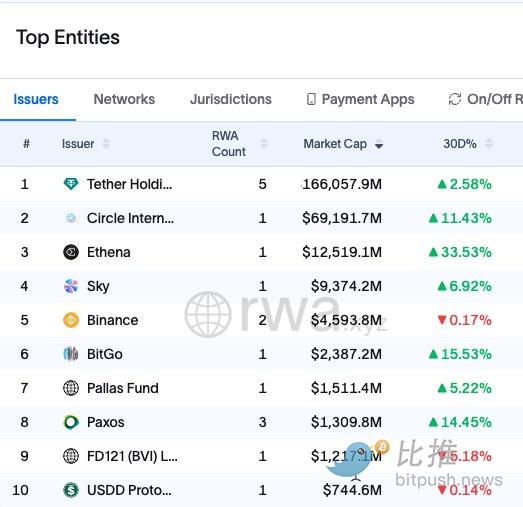In the long-term monopoly of the stablecoin market by the two giants, USDT and USDC, the USDe launched by Ethena is rapidly gaining momentum.
With the "support" of former BitMEX CEO Arthur Hayes, the circulating market value of USDe has surpassed $12.5 billion, with an increase of nearly 35% in just one month, far exceeding USDT and USDC, making it the third largest dollar-pegged stablecoin globally, after Tether and Circle.

Mechanism: Hedging Between Spot and Perpetual Contracts
Unlike USDT and USDC, which rely on reserves of dollars or government bonds, USDe adopts a "crypto-native" stabilization mechanism.
Users deposit ETH, BTC, or stETH into the protocol, and Ethena simultaneously goes long on these spot assets while establishing equivalent short positions on centralized exchanges. This way, regardless of market price fluctuations, the profits and losses from the spot and short positions largely offset each other, thereby maintaining USDe's stable peg around $1.

On this basis, Ethena has launched sUSDe. Due to the long-term positive funding rates of perpetual contracts, the protocol distributes profits to users who stake USDe.
The core advantages of this mechanism are:
- High Yield: USDe provides users with high yields by staking ETH and utilizing the funding rates of perpetual contracts, with current annualized yields far exceeding traditional stablecoins.
- Decentralization: USDe does not rely on traditional banking systems and is seen as a "crypto-native" solution.
- Market Demand: With new regulations like the U.S. GENIUS Act prohibiting regulated stablecoins from offering yields, USDe's non-bank design has attracted a large amount of capital seeking returns.
Currently, the annualized yield of sUSDe has reached 9%, significantly higher than the 4.2% for USDC on Aave, which is a key reason for the continuous influx of funds.
Data: Explosive Growth

Data from RWA.xyz shows that USDe has experienced significant growth in recent months. Its market value has risen to $12.52 billion, an increase of over 30% compared to 30 days ago. The number of holding addresses is close to 40,000, with monthly active addresses exceeding 20,000, an increase of nearly 40%. Monthly on-chain transfer volume has reached $57.8 billion, indicating its widespread application in settlements and payments.
Since July, the market value curve of USDe has steepened significantly, indicating that it benefits from favorable stablecoin legislation and the attractiveness of high yields.
It is worth noting that USDe is almost entirely deployed on the Ethereum mainnet, with only $7.3 million on Solana. This means that USDe's liquidity is highly concentrated, and any fluctuations in the Ethereum ecosystem may test its stability.
Fee Switch: The "Dividend Moment" for Governance
In addition to the surge in scale, the market is more focused on the Fee Switch being advanced by Ethena. This is a milestone at the governance level: once activated, a portion of the protocol's revenue will be distributed to ENA holders or injected into the treasury, transforming ENA from a "governance token" into an "asset with cash flow expectations."

To implement this mechanism, Ethena has set three conditions: USDe's circulation exceeds $6 billion, cumulative revenue reaches $250 million, and integration is completed with at least four of the top five derivatives exchanges globally. The first two conditions have been met, with only the last one still in progress.
The potential impact of the Fee Switch is twofold. For ENA holders, this means that the token's value will be linked to the protocol's revenue, further increasing market attention. However, for sUSDe holders, if the profit distribution comes from the same revenue pool, the yield may be diluted. Finding a balance between token value return, user yields, and risk buffering will be a key test for Ethena in the future.
Risks: Instability Behind High Yields
The rapid rise of USDe is not without concerns. The core challenges for USDe lie in the volatility of funding rates, counterparty risks from centralized exchanges, and liquidity management under extreme market conditions.
First, its yields depend on funding rates; if the market enters a bear phase and funding rates turn negative, the high yields of sUSDe may vanish instantly.
Second, its hedging mechanism heavily relies on centralized exchanges, and if an exchange encounters a black swan event, the protocol's risk exposure will be difficult to control.
Additionally, Chaos Labs has warned that the re-staking of Ethena's assets could trigger a liquidity crisis in DeFi lending platforms, while S&P Global has even assigned a risk weight of 1250% to USDe in its credit rating, far exceeding that of USDT and USDC. These concerns highlight the potential vulnerabilities of the USDe model.
However, despite these potential risks, since its launch in 2023, USDe has not faced any liquidity crises nor has it deviated significantly from its dollar peg target. This indicates that the future of USDe will be a game between its design risks and actual operational capabilities. Whether it can continue to effectively address market challenges while maintaining high yields will be key to determining its ability to establish a foothold in the cryptocurrency ecosystem.
免责声明:本文章仅代表作者个人观点,不代表本平台的立场和观点。本文章仅供信息分享,不构成对任何人的任何投资建议。用户与作者之间的任何争议,与本平台无关。如网页中刊载的文章或图片涉及侵权,请提供相关的权利证明和身份证明发送邮件到support@aicoin.com,本平台相关工作人员将会进行核查。




